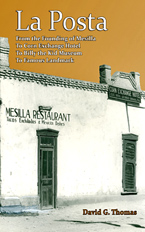Archive for the 'Agriculture' Category
Monday, February 1st, 2010
Picacho Peak

Picacho Peak, 4959 feet, about 7 miles from Las Cruces. (Click for a larger image.)
The old village of Picacho is located southeast of the peak, at the edge of the Mesilla Valley. Picacho was a stage stop on the Butterfield Overland Stage Line , the first stop after Mesilla. From Picacho, the stage climbed the mesa and went around the north side of Picacho Peak through Box Canyon. This lead to a very difficult route through several mountain ranges, but was the only route on which water could be supplied at the stage stops, which were located about one hour of travel time apart.
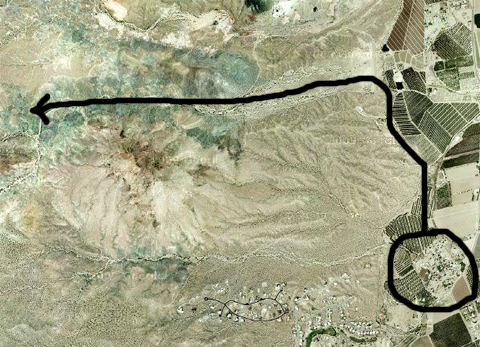
From Mesilla the stage stops to the Arizona border were: Picacho, Rough and Ready, Goodsight, Cooke’s Springs, Mimbres, Cow Springs, Soldiers’s Farewell, Barney’s, Steins Peak.
The Butterfield Stage began operation on September 15, 1858, with stages leaving San Francisco and St. Louis, the two ends of the line, on that day. Mesilla was located about the middle of the route.
The Butterfield Stage was put out of operation by the start of the Civil War.
See also:
Picacho Cemetery
Picacho — A Brief History
Picacho — Forgotten Butterfield Stage Stop
Rough and Ready — Butterfield Stage Stop
Stage Coach from Mesilla – Unfulfilled Promise
Mesilla Stage Coach – More
Tags: History, Mesilla, Stage Coach, Butterfield Overland Mail
Wednesday, September 30th, 2009
This Year’s Chiles
Are ready and are being picked.

Many say the best chiles in the world come from Hatch.
Don’t believe it. The best chiles come from Mesilla.



Tags: Chiles, Chile Rellenos, Peppers
Wednesday, October 1st, 2008
Reflections in a Pecan Wood
Research has indicated the best way to irrigate pecan trees is flood irrigation. This may appear to be an inefficient use of water, but this method leads to deep irrigation that encourages the tree roots to grow deeply. The water available to the deep roots reduces the need for surface irrigation.
In Doña Ana County we have over 18,000 acres of pecan orchards. So this time of the year the back roads of the Mesilla Valley stretch through thousands of pecan fields being irrigated.
The symmetrical planting of the trees creates endlessly fascinating views. But when you add the spectacular effects of sunlight glistening through the leaves and branches, and the reflections in the waters below, you have some of most remarkable visual delights ever seen.
These photos were taken today of a pecan field being flood irrigated. Click on each image for a larger view. It’s almost impossible to determine where reality ends and reflection begins.



Other pecan posts:
Pecans — The Cadillac of Nuts
18,000+ Acres
Pecan Harvesting
Pecan Pruning
Tags: Flood Irrigation, Pecans
Monday, September 29th, 2008
Man Killed by Chilli
“An aspiring chef died after eating a super-hot chilli sauce as part of an endurance competition with a friend.”
“Andrew Lee, 33, challenged his girlfriend’s brother to a contest to see who could eat the spiciest sauce that he could create.”
“The fork-lift truck driver, who wanted to cook for a living, prepared a tomato sauce made with red chillies grown on his father’s allotment. After eating it, however, he suffered intense discomfort and itching. The following morning he was found dead, possibly after suffering a heart attack.”
“He apparently got into bed at 2.30am and started scratching all over. His girlfriend scratched his back until he fell asleep. She woke up and he had gone. It is incredible. Who would have thought he could have died from eating chilli sauce? We don’t know of anything else that could have caused his death. The postmortem showed no heart problems.”
Source: The Times Online, September 29, 2008
Sunday, September 28th, 2008
Chiles Being Picked
The chiles are being picked now, which is done by hand for most varieties. These photos were taken while other parts of the field were being harvested.

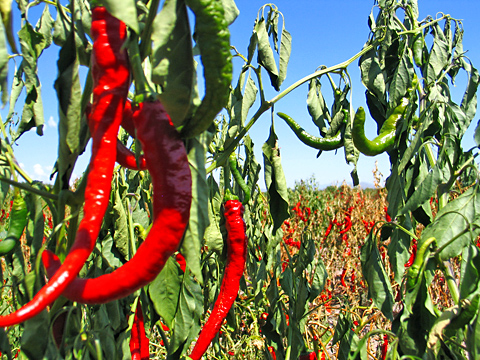

Tags: Chiles, Chile Rellenos, Peppers
Tuesday, February 27th, 2007
Mount Bhut Jolokia
Just as soon as Bhut Jolokia is identified as the hottest chile in the world, someone steps forth to conquer it.
Guwahati, India – A woman from India’s north eastern state of Assam is hoping to set a world record by eating a maximum amount of chilies in the least time. If successful, Anandita Dutta Tamuly will also be the world’s first person to eat a massive quantity of the world’s hottest peppers.
Tamuly is extremely confident of besting the pepper, because she’s an experienced summiter already.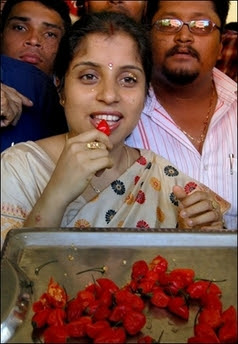
“I have created history on Indian television by munching 60 of the chilies in two minutes. I am more than confident of creating a record once I reach London.”
“I have been eating Bhut Jolokia since my childhood and never felt the hotness in my mouth. I can even break the chilli and splash it on my eyes. I tried this on TV and had no problems whatsoever.”
The Assam government will pay for her trip to set the record. The previous world record appears to be 8 jalapenos in a minute, a pretty small bump compared to 60 Bhut Jolokias and a little Bhut Jolokia eyewash.
One consequence of the chile’s new fame is its price is climbing.
“We never thought Bhut Jolokia was so hot until news came in that this is the world’s hottest chilli. Now we have hiked the prices by Rs.50 a kg and people are buying it like hot cakes,” said Nalini Ram Thakuria, a vegetable vendor in Guwahati.
Note: In New Mexico, it’s spelled “chile,” not “chili.”
Tags: Chile, Chili, Bhut Jolokia, Anandita Dutta Tamuly
Monday, February 19th, 2007
World’s Hottest Chile
An NMSU professor has identified what is evidently the hottest chile in the world:
In fall of 2006, the Guinness Book of Records confirmed that New Mexico State University Regent’s Professor Paul Bosland had indeed discovered the world’s hottest chile pepper, Bhut Jolokia.
Bhut Jolokia, at 1,001,304 Scoville Heat Units (SHU), is nearly twice as hot as Red Savina, the chile pepper variety it replaces as the world’s hottest. A New Mexico green chile contains about 1,500 SHUs and an average jalapeno measures at about 10,000 SHUs.
“The name Bhut Jolokia translates as ‘ghost chile,’” Bosland said, “we’re not sure why they call it that, but I think it’s because the chile is so hot, you give up the ghost when you eat it!”
According to Bosland, Bhut Jolokia is a naturally occurring inter-specific hybrid indigenous to the Assam region of northeastern India. A member of NMSU’s Chile Pepper Institute visiting India sent Bhut Jolokia seeds back to NMSU for testing in 2001.
“The plant doesn’t set fruit very well, so it took a couple of years to get enough for field testing,” Bosland said.
The Scoville Heat Units scale for measuring pepper hotness is named in honor of Wilbur Lincoln Scoville, who invented the first method of measuring hotness. The hot substance in chiles is capsaicin. Pure capsaicin has a Scoville Heat rating of 15 to 16 million.
The Chile Pepper Institute was established in 1992 and is located at New Mexico State University.
Tags: Hottest Chile, NMSU, Chile Pepper Institute, Capsaicin
Wednesday, January 3rd, 2007
Pecan Pruning
After the harvest, pecan growers have one last, big task — pruning the trees.
Pecan trees are pruned for several reasons. The main reason is to keep the trees smaller, which makes harvesting and tree care easier. But pruning also helps increase or maintain yields and improve nut quality.
Big trees are pruned using a rideable, motorized arm:
The operator can drive through the orchard and raise or lower the arm as needed.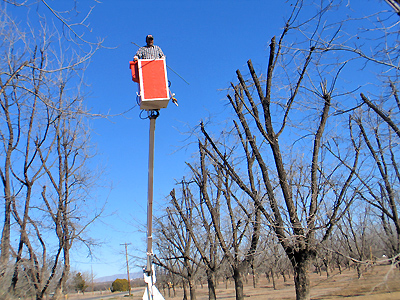
Pruning requires skill. Trees must be cut in the right way, dead limbs recognized and taken out, and narrow crotches removed.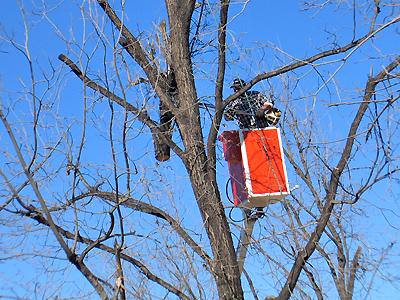
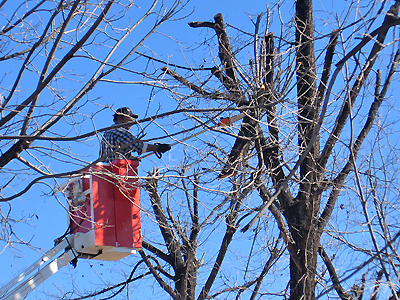
The prunings must be cleared so that they don’t interfere with the care of the trees or serve as a host for disease or insects.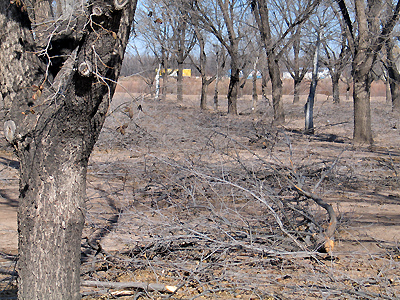
The prunings are first stacked, then hauled off and burnt. No viable economic use for pecan prunings has been found, so burning is currently considered the best disposal option.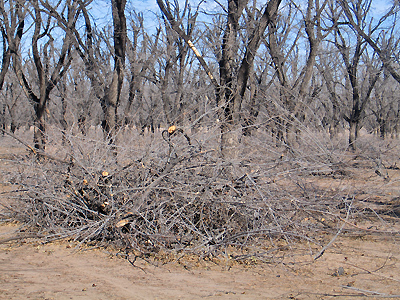
Until they began to leaf out and grow, pruned trees look buzz-cut.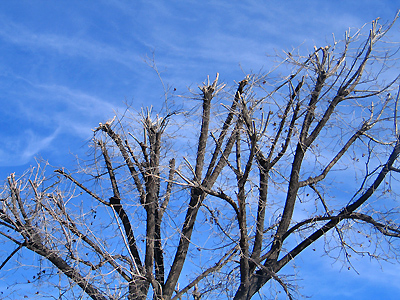
Tags: Pecan Pruning, Motorized Arm, Rideable Pruning Arm
Monday, December 18th, 2006
No Trespassing
As you drive the backroads around Mesilla, through the 18,000+ acres of pecans in the county, you will see these little signs every where:
Why such concern about trees? They are not going to be damaged by people walking under them.
Here’s the reason: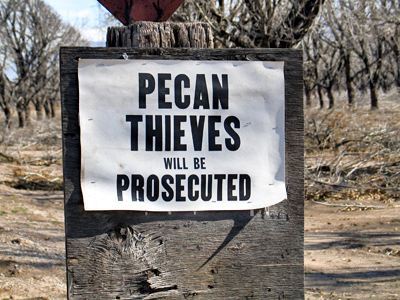
Tags: Pecan Thieves
Monday, December 4th, 2006
Pecan Harvesting
The 2006 pecan harvest is almost finished.
The trees are ready for harvest when most of the protective shucks have split. You can see the open shucks and pecans here: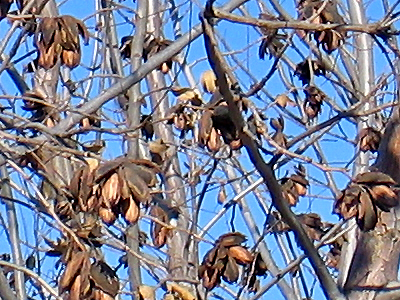
Pecan trees alternate between high yield and low yield years. This year is a low year for this area. Production in a low year can be as little as 1/3 of a high year.
Here is a tree from an orchard with an excellent yield this year, perhaps because the trees are younger and were recently transplanted.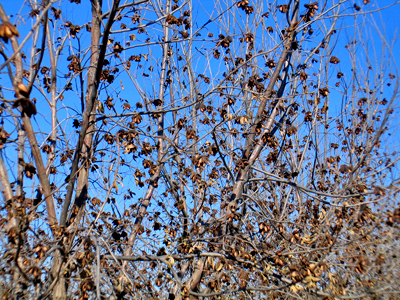
The first step in harvesting is getting the nuts out of the tree. This is done with a shaker: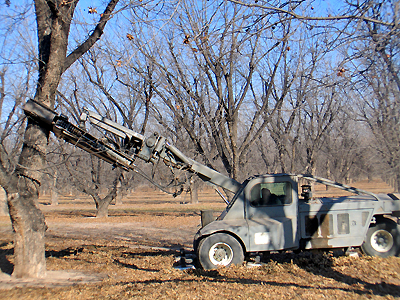
The trees are shook for about 2 or 3 seconds and you can feel the shaking in the ground 20 or 30 feet away. The going rate to get your trees shook if you don’t own a shaker is $5 a tree.
Sometimes it is necessary to shake several branches of a large tree.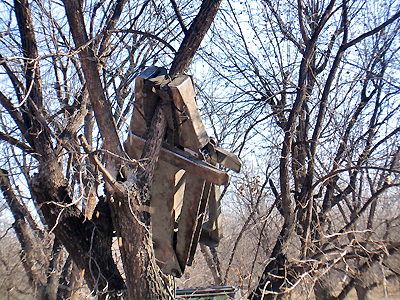
Here you can see pecans falling as the tree shakes.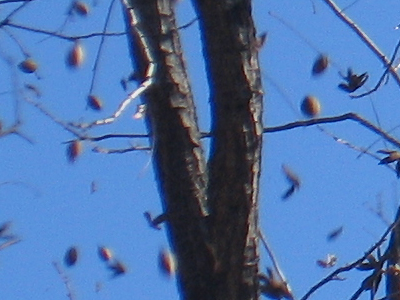
The shaker shakes out anything that will fall, including shucks, leaves, and twigs. All of this joins the leaves which have already fallen from the tree, so the second step is to use a windrow machine to rake this material into rows.
The last step in harvesting is to use a sweeper to pick up the leaves and debris and pecans and separate the pecans. Here’s a sweeper in action.
The sweeper stores the nuts in a bin and grinds the leaves and debris and returns it to the soil.
Here are what trees look like after harvest.
Doña Ana county produces more pecans than any similarly-sized area in the world.
Tags: Pecan Harvest, Pecan Shaker, Pecan Sweeper







